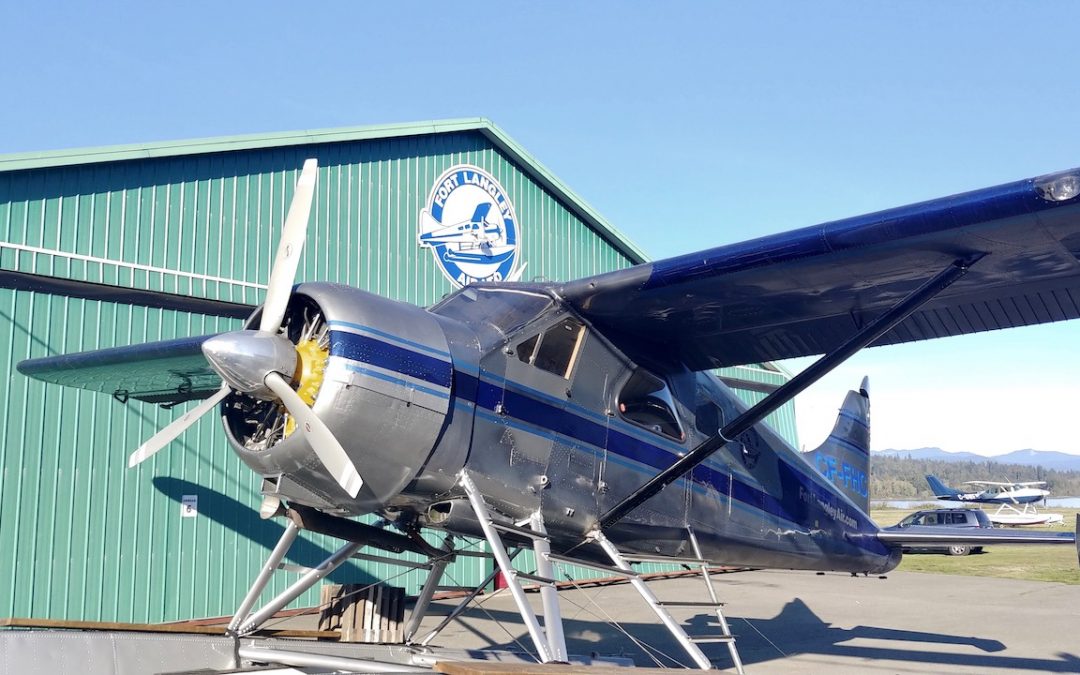Without a doubt, the De Havilland Beaver is a legendary Canadian bush plane. Fort Langley Air has been expanding its fleet since Scott McIntosh purchased FLA in May, 2018, acquiring two DHC-2 Beavers and a Cessna 180 over the summer.
The De Havilland Beavers will be a focus of the business going forward. McIntosh will use the Beavers and their recently acquired C180 C-FYQQ to train bush pilots, stay number one in pilot tourism and to expand the capacity of their charter offer.
Beaver #12, a silver beauty was built in 1948, and has been in service ever since. When asked why the DHC-2 Beaver is so favoured by pilots John Ferguson says, “It’s an iconic airplane. When I started off it was the holy grail – it was the big airplane for float flying until turbines came along. [Being allowed to fly] it was how you knew you’d arrived as a bush pilot.” Fort Langley Air has installed the Viking push-out windows and revised door latch kits on both planes to improve passenger safety, as well as all new avionics and GPS systems.
Rounding out the inventory at FLA is the striking red, white and blue C-FCQP. Built in 1953, Beaver #370 came out of private ownership and is going back into commercial use as Fort Langley Air’s main charter airplane. CQP has been impeccably maintained over the years by its previous owner. “I am excited to have it become one of the planes in the Fort Langley Air fleet. We saw it and we had to have it!” says Scott McIntosh.
Pilot Brad Nelson, who has recently joined the Fort Langley Air team of highly seasoned bush pilots says, “The Beaver was always just one of the best seaplanes around – nothing could touch it for performance. That is why they are still widely used by many float plane operators today. It can get in and out of small lakes at higher altitudes. And up to about 5000 feet it performs just as well as at sea level.”
The Beavers will allow FLA to haul more and operate in areas where the Cessna is not suitable. In addition, the iconic Canadian bush plane is a big draw for the international pilot who cannot experience this type of flying at home. Says McIntosh, “At Fort Langley Air, we can offer seasoned pilots, particularly those from Europe, a taste of the freedom that Canadian bush pilots know well. In Europe there are very few seaplanes, and very few places that you can fly without of strictly controlled parameters.”
The same taste of freedom appeals to Canadian commercial pilots. John Crawford, FLA’s Chief Pilot knows that, “Pilots who spend the day flying commercial airliners often miss the responsive feel of a small float plane. We have installed dual yokes in our planes. We’ll pick up pilots at the South Terminal on the water and take them out for float training on their layover. The bonus is that they get to combine sightseeing with a chance to learn to fly a floatplane.” In special cases Fort Langley Air is willing to offer their Premier Pilots – company-approved highly seasoned float pilots – the opportunity to charter solo, either because they wish to retain their certification, or just want to enjoy a self-fly experience on the BC Coast. Typically these pilots work with Fort Langley Air for a few days to earn their status as a Premier Pilot.
McIntosh intends to continue to expand the charter business, serving not only tourism and sightseeing clientele but industry in BC as well. Fort Langley Air has secured a new hangar in Pitt Meadows to facilitate growth and new service offerings and will continue to expand the training programs at the Fort Langley Airport. “I am just honoured to participate in a business with such a rich aviation history, in a community like Fort Langley and the environs. “Fort Langley Air is a chance to leverage my transportation industry knowledge, in a business I am passionate about, with a great team that loves to share their knowledge of flying and the wild BC Coast. I will continue to build the company and maintain our reputation as the place float pilot careers take off – a legacy that was established so many years ago.”


Recent Comments